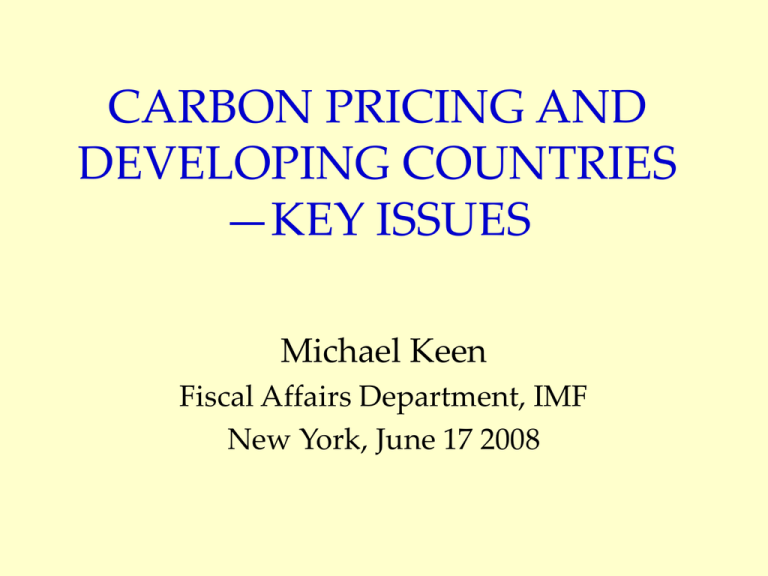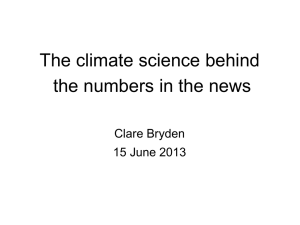Michael Keen is Advisor in the Fiscal Affairs Department of the International Monetary Fund, having been until recently head of the Tax Policy Division. Before joining the Fund, he was Professor of Economics at the University of Essex (U.K.), and visiting professor at Queen s University (Canada) and Kyoto University (Japan). He was President of the International Institute of Public Finance from 2003 to 2006, and is currently a member of the Board of the National Tax Association. He has written on a range of issues in theoretical and applied public finance, with publications in the American Economic Review, Journal of Public Economics, National Tax Journal, and elsewhere, is co-author of The Modern VAT, and has consulted for the World Bank, European Commission, the House of Lords and the private sector.
advertisement

CARBON PRICING AND DEVELOPING COUNTRIES —KEY ISSUES Michael Keen Fiscal Affairs Department, IMF New York, June 17 2008 CONTEXT Developing countries are: • Responsible for relatively small part of GHG stock • Likely to generate bulk of future emissions • Most vulnerable to CC Curbing emissions raises issues of both: • Efficiency—to avoid wasting resources • Equity—across generations, countries, individuals CARBON PRICING—PRINCIPLES Can be implemented in many ways—carbon tax, cap-and–trade, hybrids—common objective being to face emitters with a price reflecting global damage they cause Price path needs to be: Credible, with price rising over a long period In ‘first-best’, uniform across sources and countries (will return to this…) A quick reality check… Initial levels of carbon price commonly proposed— $15-$60 per tC (= $2-$8 per barrel of oil)—are dwarfed by recent oil price increases BUT that does NOT mean carbon pricing now unnecessary: The external damage is still there… …and whether it is higher or lower than we thought depends on whether current prices reflect demand or supply shock Credibility of increasing future prices critical THE UNIFORMITY ISSUE • Intuition: Since damage is the same wherever and however emissions arise, so should be their price • But ‘first-best’ presumes that any equity concerns (across and within countries) are dealt with by other means (including, in principle, cross-country transfers)… • …which is likely to be the case in developed countries—but, otherwise, there is a case for a lower charge on poorer individuals Caveats to case for lower carbon pricing in some countries: • In terms of equity, low fuel prices: Are expensive in foregone revenue, and may Not be the best-targeted way to help the poor Exacerbate local pollution • ‘Leakage’ is a concern Likely extent remains unclear, though a few sectors seem key Possible policy responses: Border tax adjustment; Sectoral agreements REVENUE ISSUES Both carbon taxation and international cap-and-trade are possible sources of revenue (in latter case, so long as emissions rights not ‘grandfathered’)—a potential benefit: 7 IGSM 6 5000 5 4000 450 ppm 4 3000 3 2000 2 550 ppm 1000 1 650 ppm 0 0 2020 2040 450 ppm 2060 550 ppm 2100 650 ppm 1000 900 7 Minicam 6 Carbon prices US$/tC (2000) 800 5 700 450 ppm 600 4 500 550 ppm 400 3 300 2 200 650 ppm 1 100 0 0 2020 2040 450 ppm 2060 550 ppm 2100 650 ppm Annual Carbon tax revenue as percentage of global GDP Carbon prices US$/tC (2000) 6000 8 Annual carbon tax revenue as percentage of global GDP 7000 • Proper use of this will be country-specific • Earmarking—to roads, environmental spending…—may help politically, but in economic terms is not necessary and can be damaging • International cap-and-trade (which in itself will imply uniformity across countries) leads in addition to cross-country flows, extent/direction of which depend on how emission rights are allocated • Most schemes analyzed have OECD as net buyers of permits, and Africa and India as sellers—but differ e.g. on whether China a buyer or a seller MACROECONOMIC EFFECTS These are examined in IMF’s Spring 2008 World Economic Outlook, using G-cubed, a calibrated intertemporal general equilibrium model Common tax imposed to achieve a 60 percent reduction relative to the 2002 level in world (energy-based) carbon dioxide emissions by 2100 Macroeconomic impacts generally modest: United States Japan Eastern Europe and Russia Consumption 1.0 0.5 0.0 -0.5 -1.0 -1.5 -2.0 -2.5 -3.0 -3.5 2013 Investment Output 0 5 0 -5 -5 -10 -10 -15 -15 -20 -20 -25 -25 -30 20 30 40 Interest Rate 0.0 -0.1 -0.2 -0.3 -0.4 -0.5 -0.6 -0.7 -0.8 -0.9 -1.0 2013 Western Europe OPEC China Other developing and emerging economies 2013 20 30 2013 40 Real Effect. Exchange Rate (percentage points) 20 30 40 Current Account (percent of GDP; percentage points) 10 2.5 5 2.0 1.5 0 1.0 -5 0.5 -10 0.0 -15 -0.5 -1.0 -20 20 30 40 2013 20 30 40 2013 20 30 40 NOTE: Output refers to gross national product, interest rate refers to 10-year real interest rate. For real effective exchange rate, a positive value is an appreciate relative to the baseline. Implied financial flows under cap-and-trade: By Initial Emissions Shares By Population Shares (percent of GDP) (percent of GDP) United States 2020 2030 2040 Japan Western Europe China Other emerging and developing economies Eastern Europe and Russia OPEC -3 0 3 6 9 12 -3 0 NOTE: A positive value denotes a receipt of transfers—the region is selling its emission rights. 3 6 9 12



